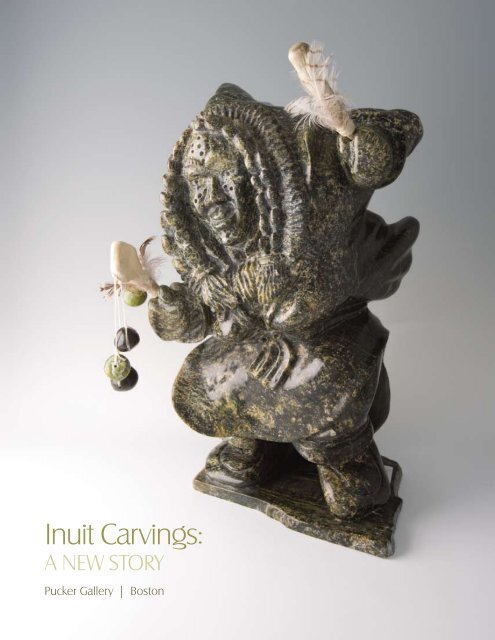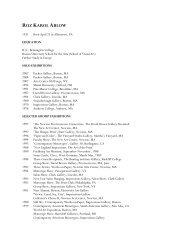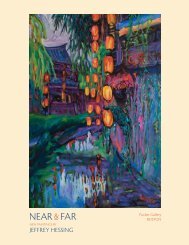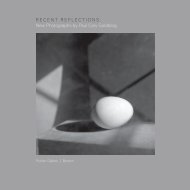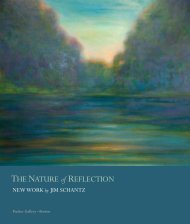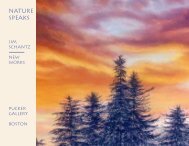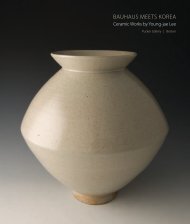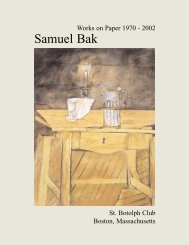Inuit Carvings: - Pucker Gallery
Inuit Carvings: - Pucker Gallery
Inuit Carvings: - Pucker Gallery
Create successful ePaper yourself
Turn your PDF publications into a flip-book with our unique Google optimized e-Paper software.
<strong>Inuit</strong> <strong>Carvings</strong>:<br />
A New Story<br />
<strong>Pucker</strong> <strong>Gallery</strong> | Boston<br />
23
2<br />
<strong>Inuit</strong> <strong>Carvings</strong>: A New Story<br />
In Cape Dorset on south BaffIn IslanD,<br />
just as in ages past, bears, birds, walrus, and hunters emerge<br />
from rocks that line the coast. Men carve these animals from<br />
the stone they quarry by hand. they oil and polish the animals<br />
to shine, letting each burst of green show forth from the Baffin<br />
soapstone. then the animals are released. they fly, they swim<br />
and hunt, they dance. the men sell the animals away to the<br />
south, away from their homeland. there they dance forever, a<br />
piece of the north living in the south. <strong>Inuit</strong> stone carvings tell the<br />
stories of their past.<br />
the <strong>Inuit</strong> art of storytelling has endured since the prehistoric<br />
age. every element and being in the <strong>Inuit</strong> world has its own<br />
story. together, these stories tell how their chilly world came<br />
to be and explain how that Northern world works. If one looks<br />
long enough at the extraordinary volume of contemporary<br />
<strong>Inuit</strong> sculpture it begins to tell a legendary story of the past,<br />
and points towards the bright future. the particular story of<br />
<strong>Inuit</strong> sculpture is one that speaks of the history of the <strong>Inuit</strong><br />
people; it is a new, visual form of storytelling. today that story<br />
also suggests that<br />
sculpture carving is ever<br />
changing to adapt to<br />
new influences upon<br />
<strong>Inuit</strong> culture and society,<br />
and continually adapting<br />
to meet modern market<br />
influences.<br />
the contemporary<br />
<strong>Inuit</strong> art movement<br />
began as a commercial<br />
venture. the sculpture<br />
market is an operation<br />
that spans the whole of<br />
Nunavut (formerly of the<br />
Northwest territories),<br />
and trickles down toward<br />
the south via multiple<br />
channels. thanks to the tommy takpani (Cape Dorset)<br />
Bear | soapstone<br />
expanse of the <strong>Inuit</strong> art 5 x 9 x 3" | In700<br />
Cover:<br />
pootoogook Jaw (Cape Dorset)<br />
spIrIt DanCer | soapstone<br />
18 x 10 x 6" | In654<br />
network, these works exist in art collections all over our globe.<br />
today the stories <strong>Inuit</strong> carvings tell are not always the<br />
traditional legends of the prehistoric and historic <strong>Inuit</strong> ancestors.<br />
these ancestors were the Dorset and thule people, who<br />
inhabited the northern territories of Canada, almost entirely<br />
isolated from the rest of the world, until the late 18th century.<br />
<strong>Inuit</strong> art of today tells of a nomadic hunting people who, since<br />
the 1950s, have been changed by the modernity of western<br />
society, they are settled in modern homes and villages, and are<br />
building their own identity in the context of a new way of life<br />
and a new territory—Nunavut.<br />
Looking at tommy takpani’s Bear (IN700) or Pootoogook<br />
Jaw’s Spirit Dancer (IN654), it is easy to imagine an idealized<br />
<strong>Inuit</strong> experience. Memories of living on the land endure, yet<br />
the younger <strong>Inuit</strong> generations have known only a modern<br />
existence. they have never hunted on dogsleds, never built<br />
an igloo camp, never moved their home to follow the caribou<br />
herds in summer months. <strong>Inuit</strong> today are concerned with<br />
the issues of modern society: how to make a living, gain<br />
access to healthcare<br />
and education, and<br />
overcome social issues<br />
such as domestic unrest<br />
and drug and alcohol<br />
addiction. Contemporary<br />
<strong>Inuit</strong> sculptors have<br />
different ways of<br />
grappling with two<br />
conflicting identities:<br />
one of the past, and<br />
one of the present<br />
within the context of an<br />
unknown future.<br />
In the new<br />
contemporary sculpture,<br />
stone hunters hunt<br />
stone bears, walruses,<br />
caribou, and whales;<br />
stone mothers carry
“Back in the 1980s I was asking myself, ‘how will I<br />
make art?‘ It didn’t make sense to me to carve scenes<br />
of traditional life because I was not there, so I began to<br />
carve from my own experiences—both happy and sad.”<br />
— artIst ovIloo tunnIllIe i<br />
their children and work<br />
leather and tapestry; stone<br />
shamans communicate<br />
with other worlds. these<br />
images recall a past<br />
closely tied to the land<br />
and sea, independent of<br />
the trappings of southern<br />
culture. Artworks with these<br />
“traditional” subjects help to<br />
record the history of when<br />
the <strong>Inuit</strong> lived off the land,<br />
and in recent years these<br />
images have been inspiring<br />
a renewed pride and desire<br />
to preserve traditional <strong>Inuit</strong><br />
culture. Contemporary<br />
sculpture also shows men<br />
on snowmobiles and<br />
AtVs, and illustrates the<br />
integration of southern<br />
society into the <strong>Inuit</strong><br />
identity with carved items such as desks, chairs, and guitars.<br />
Art making in Nunavut is an occupation rarely idealized or<br />
romanticized as it is in the “South.” “<strong>Inuit</strong> existence has always<br />
been about survival.” ii tupilak<br />
Whalebone<br />
7 x 1 ½ x 1" | In642<br />
Sculpture making started as a modern<br />
mode of survival. Carving art sculptures requires hard work and<br />
skill, and is rewarded with funds that allow artists to generate<br />
income. Artists can have homes, vehicles for transportation, buy<br />
supplies from the South like food and sculpting tools, and buy or<br />
quarry stone for continued production. Many artists, when asked<br />
about the artistic process or their inspiration to create sculpture,<br />
say that they carve stone as an alternative to hunting for food, or<br />
working the few jobs available in construction or mines.<br />
the most famous and successful artist community in<br />
Nunavut is Cape Dorset, a small settlement on the southwestern<br />
tip of Baffin Island. Its sculptures are known for their exceptional<br />
craftsmanship, artistry, and style. of the many art making<br />
communities in the <strong>Inuit</strong> territory, the confluence of Cape<br />
tupilak<br />
Whalebone<br />
4 ½ x 1 ¼ x ½" | In640<br />
Dorset’s unique historical<br />
development and geographic<br />
situation prepared it for<br />
particular artistic excellence.<br />
the art of carving is a<br />
longstanding tradition of the<br />
Cape Dorset region, practiced<br />
long before the thule ancestors<br />
of today’s <strong>Inuit</strong> migrated from<br />
the west in 1000 Ce. the<br />
prehistoric Dorset people,<br />
who hunted the eastern<br />
coasts of north Canada from<br />
roughly 500 BCe until around<br />
1400 Ce, practiced an early<br />
tradition of object carving,<br />
though it is suspected there<br />
was no word for or concept<br />
of “art” as we think of it today.<br />
Artifacts from this region<br />
reveal great attention to the<br />
craftsmanship of small hand<br />
tools in ivory, bone, and sometimes stone. Among the small<br />
artifacts archaeologists have found are also small, figurative<br />
ivory carvings thought to have been used in religious or spiritual<br />
ceremonies by early shamans. these small masks and figurines<br />
show intricately carved humans, animals, and talismans. they<br />
may have looked similar to the tupilaks from Greenland in this<br />
exhibition (IN640, IN641, and IN642).<br />
the carving tradition of the <strong>Inuit</strong> ancestors endured for<br />
hundreds of years, and when european explorers encountered<br />
Cape Dorset and its <strong>Inuit</strong> peoples in the 1770s, the <strong>Inuit</strong> traded<br />
small carved toys, knives, tools, and figurines with them. early<br />
carving trade and market-style interaction with visitors to the<br />
Cape Dorset area continued through the mid-20th tupilak<br />
Whalebone<br />
5 x 2 ¼ x 2" | In641<br />
century, when<br />
small carvings were sold as tourist souvenirs.<br />
the arrival of James Houston to Cape Dorset in 1949<br />
heralded the beginning of contemporary <strong>Inuit</strong> sculpture as<br />
known today, and as exhibited in museums and galleries<br />
3
4<br />
noah Jaw (Cape Dorset)<br />
KayaKer | soapstone<br />
4 x 15 x 5" | In653<br />
including <strong>Pucker</strong> <strong>Gallery</strong>. the influence of the west Baffin<br />
eskimo Co-operative, established in 1960, on the art community<br />
of Cape Dorset cannot be overstated. the Co-op’s focus on<br />
art was first nurtured by Houston, and was further developed<br />
by its second director, terry ryan. these two southern artists<br />
encouraged the <strong>Inuit</strong> community to make carvings as art for<br />
sale, taught and developed a vibrant printmaking studio, and<br />
with the Co-op developed a market, and sales and distribution<br />
system that allowed Cape Dorset artists to make substantial<br />
livings. the Co-op’s activity, led by Houston and ryan, allowed<br />
artists to develop their own skills and styles in a supportive,<br />
enthusiastic, and encouraging community. oftentimes only the<br />
Co-op’s resources allowed artists access to raw stone material<br />
and tools needed for carving. this nurturing environment built<br />
primarily by Houston fostered the individual artists who would<br />
become the masters of modern <strong>Inuit</strong> sculpture, including<br />
Kenjouak Ashevak, Kiawak Ashoona, osuitok Ipeelee, Nuna Parr<br />
(whose walrus, IN643, can be seen in this exhibition), Paulassie<br />
Pootoogook, and oviloo tunnillie. Stories of and memorials to<br />
these legendary carvers have themselves been immortalized in<br />
stone on Baffin Island.<br />
It is from these masters that the younger generation of<br />
artists learned their skills. Sculptors of Cape Dorset, and many<br />
<strong>Inuit</strong> regions, commonly learn the art from their parents and<br />
relatives. Noah Jaw (Kayaker, IN653), Ashevak Adla (walrus,<br />
IN664), Ashoona Ashoona (Bear, IN690), Qiatsuq Pootoogook<br />
(transformation, IN662), and others, are all children or relatives<br />
of great Cape Dorset carvers. Perhaps due to the unusually<br />
supportive and encouraging community, and distinct from<br />
other <strong>Inuit</strong> carving communities, Cape Dorset artists work<br />
independently and are often recognized for their individual<br />
carving accomplishments and unique styles. this is much more<br />
reminiscent of the “southern” figure of the exalted individual<br />
artist. Individual sculpture<br />
styles can be recognized<br />
in everything from<br />
composition, to the type<br />
of stone used, to subject matter, or even a sculpture’s surface<br />
finish. All these elements vary widely in Cape Dorset sculpture<br />
because the stone resources available specifically to Cape Dorset<br />
artists are diverse and versatile, rare among Nunavut regions.<br />
the geography of Baffin Island held large quantities of<br />
versatile stone which, while immensely difficult and treacherous<br />
to quarry, provided consistent supplies of stone relative to<br />
other Nunavut regions. Stone on Baffin Island is most often a<br />
soft soapstone, or serpentine, easily carved with hand tools.<br />
Serpentine is found in a wide variety of colors and textures, most<br />
often of green, gray, and black, and Cape Dorset serpentine<br />
is often distinctive for a particular shade of jade-green. white<br />
marble is also available on Baffin Island, and artists have begun<br />
to use it when they have the necessary power tools to properly<br />
carve this much harder stone. Cape Dorset artists use a highly<br />
polished and shiny finish on their works, created using oils, wax,<br />
ashoona ashoona (Cape Dorset)<br />
Bear | soapstone<br />
5 x 4 ½ x 10" | In690
sandpapers, steel wool, or<br />
seal oil.<br />
the specific block of stone<br />
dictates each sculpture’s visual<br />
properties. Artists pay close<br />
attention to and respect the<br />
stone. they let the stone’s<br />
particular characteristics<br />
dictate the form of the work by<br />
following mineral lines or veins,<br />
incorporating or using cracks to<br />
inform compositional decisions,<br />
or allowing the elements of ashevak adla (Cape Dorset)<br />
Walrus<br />
a sculpture to be thin or thick 5 x 11 x 4" | In664<br />
depending on the internal<br />
structure and density of the stone. Baffin Island serpentine is of<br />
such a density as to be workable yet strong, a combination that<br />
Cape Dorset artists use to full advantage.<br />
Versatile carving stone allows for versatile craftsmanship;<br />
therefore Cape Dorset sculpture is recognizable by a few<br />
distinct visual properties made possible by the stone. Complex<br />
compositions, like those made by Pudlalik Shaa (IN685) and<br />
Peter Kakee (IN665), allow walruses to dance and birds to take<br />
flight. reduction, simplification, abstraction, and streamlining<br />
stone to create slender structures allows a greater use of<br />
negative space than in sculpture from Baker Lake, for example.<br />
Because of this, Cape Dorset artists can attempt more<br />
communicative poses to evoke humor, valor, and emotionally<br />
evocative scenes. the vast majority of <strong>Inuit</strong> sculpture is always<br />
“about” something; through their creative techniques Cape<br />
Dorset artists can adeptly tell stories and communicate complex<br />
ideas through their sculptures. Composition and content are<br />
never separate; form directly relates to a sculpture’s meaning.<br />
Perhaps because of this, Cape Dorset artists practice a stylized<br />
realism and naturalism that is at once elegant and refined, yet<br />
also creative and innovative.<br />
the <strong>Inuit</strong> form of naturalism treats “realism” as a flexible term,<br />
referring to realistic depiction as well as portrayals of events,<br />
people or supernatural elements as though they were real. to<br />
look into an <strong>Inuit</strong> sculpture’s eyes is to read an expression that<br />
directly communicates an animal’s state of being, or a human’s<br />
frame of mind at that carved instant, though each feather or<br />
eyelash are not individually delineated. Artist and <strong>Inuit</strong> scholar<br />
Ingo Hessel observes, “No matter what activity the carved figure<br />
is engaged in, something about it will be true.” iii<br />
the revered reception <strong>Inuit</strong> sculpture consistently receives<br />
is a testament to its enduring legacy as cultural record and<br />
entrancing visual art. Cape Dorset served as the artistic<br />
birthplace for <strong>Inuit</strong> sculpture, and thanks to multiple factors,<br />
Cape Dorset has emerged as the artistic and economic center of<br />
the movement. Its environment nurtured its artistic community<br />
such that as time passes, Cape Dorset artists appear more and<br />
more like the artists of the South, with recognized names, styles,<br />
exhibitions, accolades, and markets. these artists defy curators<br />
and galleries who wrestle with how to approach contemporary<br />
<strong>Inuit</strong> art.<br />
It might be argued that <strong>Inuit</strong> sculpture is in fact the most<br />
true contemporary art, one where creativity and commercial<br />
enterprise exist side by side, in open dialogue. Curators,<br />
galleries, and museums should pay close attention as artists<br />
from Cape Dorset continue to evolve, reacting to and sculpting<br />
their ever-changing way of life. Just as their relatives achieved<br />
remarkable innovation in sculpting, these artists may achieve<br />
5
6<br />
innovation in the methods of exhibition and export of their<br />
artworks. <strong>Inuit</strong> sculptors now have the opportunity to sculpt<br />
the next chapter in their collective story. —Zoe LItSIoS<br />
Zoe Litsios, <strong>Pucker</strong> <strong>Gallery</strong> intern, received her Bachelor’s degree in Art History<br />
and Italian Studies, with a concentration in Museum Studies, from Smith<br />
College and has been the exhibitions Manager at the Portsmouth Museum<br />
of Art for two years.<br />
i Susan Gustavison, Northern rock (ontario: McMichael Canadian Art Collection, 1999) 68.<br />
ii Ingo Hessel, Dieter Hessel, and George Swinton, <strong>Inuit</strong> Art: An Introduction (Vancouver: Douglas & McIntyre, 2003) 189.<br />
iii Hessel, Hessel, and Swinton, <strong>Inuit</strong> Art, 77.<br />
iv Hessel, Hessel, and Swinton, <strong>Inuit</strong> Art, 189.<br />
Qiatsuq pootoogook (Cape Dorset)<br />
transformatIon | soapstone<br />
9 ½ x 15 ½ x 9 ½” | In662<br />
SeLeCteD refereNCeS:<br />
Gustavison, Susan. Northern rock. ontario: McMichael<br />
Canadian Art Collection, 1999.<br />
Hessel, Ingo, Dieter Hessel, and George Swinton. <strong>Inuit</strong> Art:<br />
An Introduction. Vancouver: Douglas & McIntyre, 2003.<br />
Norton, Derek, Nigel reading, and terry ryan. Cape Dorset<br />
Sculpture. Vancouver: Douglas & McIntyre, 2005.<br />
“since <strong>Inuit</strong> art is not a Western<br />
art form, it should be treated<br />
by different aesthetic and<br />
other criteria, but given today’s<br />
ideological minefields, curators<br />
choose a course at their peril.<br />
to discuss <strong>Inuit</strong> art in terms of<br />
Western concepts of style and<br />
art history is to be accused of<br />
ethnocentrism and cultural<br />
assimilation; yet to treat <strong>Inuit</strong> art<br />
separately from Canadian art is to<br />
be accused of ghettoizing it and<br />
pandering to political correctness.<br />
the issues are further complicated<br />
since <strong>Inuit</strong> art is more or less a<br />
contemporary art form and not<br />
a ‘traditional’ one, and since it<br />
is created almost purely for the<br />
consumption of the culture that<br />
studies it.” iv
Davie atchealak (Iqaluit)<br />
Drum DanCer | soapstone<br />
21 x 14 x 9" | In644<br />
sukkaluk akesuk (Cape Dorset)<br />
narWhal | soapstone<br />
4 ½ x 9 ½ x 3" | In661<br />
7
8<br />
hicks<br />
Whalebone<br />
24 x 22 x 14" | In639
pitseolak niviaksi (Cape Dorset)<br />
Walrus | soapstone<br />
9 ½ x 5 x 15 ½" | In645<br />
noah Kelly (Cape Dorset)<br />
WalKIng Bear | soapstone<br />
4 ½ x 14 x 5" | In648<br />
9
10<br />
Isaac ohotuk (Cape Dorset)<br />
Whale famIly | soapstone<br />
5 x 20 x 12" | In705<br />
etidloie petaulassie (Cape Dorset)<br />
BIrD | soapstone<br />
7 x 5 x 7" | In681<br />
peter sevoga (Baker lake)<br />
mother anD ChIlD | Basalt<br />
13 x 11 x 7" | In670
etidloie petaulassie (Cape Dorset)<br />
loon | soapstone<br />
8 x 12 x 5" | In651<br />
Kelly Qimirpik (Cape Dorset)<br />
DanCIng Walrus | soapstone<br />
15 x 8 x 6" | In660<br />
etulu etidloie (Cape Dorset)<br />
loon | soapstone<br />
9 x 4 ½ x 16" | In646<br />
etidloie petaulassie (Cape Dorset)<br />
BIrD | soapstone<br />
5 x 10 x 4 ½" | In652<br />
11
12<br />
pitseoak Qimirpik (Cape Dorset)<br />
musKox | soapstone<br />
4 x 3 x 6" | In689<br />
Johnny lee pudlat (Cape Dorset)<br />
tWo Walruses | soapstone<br />
6 x 11 x 13" | In668<br />
Bazil hitanek (Baker lake)<br />
mother anD ChIlD | soapstone<br />
11 x 10 x 4" | In669
Jutai toonoo (Cape Dorset)<br />
DepresseD man | soapstone<br />
14 x 9 ½ x 7" | rp1<br />
Joe sugluk (Cape Dorset)<br />
man WIth pIpe | Quartz<br />
9 ½ x 7 ½ x 4 ½" | In663<br />
siutiapik ragee (Cape Dorset)<br />
proWlIng Bear | soapstone<br />
5 x 10 x 6" | In649<br />
13
14<br />
emBraCe | soapstone<br />
19 x 11 ½ x 7" | rp6<br />
pudlalik shaa (Cape Dorset)<br />
DanCIng Walrus | soapstone<br />
7 ½ x 6 ½ x 2" | In685<br />
Cape Dorset<br />
DanCIng Bear | soapstone<br />
8 x 5 x 2" | In692
Kelly Qimirpik (Cape Dorset)<br />
Walrus | soapstone<br />
10 x 9 x 8" | In667<br />
sukkeluk akesuk (Cape Dorset)<br />
narWhal<br />
8 x 12 x 4" | In666<br />
peter Kakee (Cape Dorset)<br />
oWl<br />
9 ½ x 6 ½ x 3" | In665<br />
15
16<br />
Johnnysa mathewsie (Cape Dorset)<br />
oWl | soapstone<br />
9 x 6 x 1 ½" | In647<br />
etulu etidloie (Cape Dorset)<br />
loon | soapstone<br />
6 x 12 x 3 ½" | In650<br />
nujalia tunnillie (Cape Dorset)<br />
DanCIng Bear | soapstone<br />
15 ½ x 7 x 8 ½" | In659
pea michael (Kimmirut)<br />
hunter | soapstone<br />
16 ¾ x 4 ½ x 17 ¾" | rp9<br />
ashevak tunnillie (Cape Dorset)<br />
Bear | soapstone<br />
7 ½ x 6 x 14" | rp7<br />
17
18<br />
peter sevoga (Baker lake)<br />
man | Basalt<br />
8 ½ x 8 ½ x 3 ½" | In675<br />
pitseolak Koperqualuq (Cape Dorset)<br />
InuKshuK | soapstone<br />
13 ½ x 7 x 4" | In671<br />
simon Killiktee (Kimmirut)<br />
musKox | soapstone<br />
5 x 10 x 3 ½" | In682<br />
a. simeoni (Cape Dorset)<br />
InuKshuK | soapstone<br />
13 x 9 x 2" | In672
ning ashoona (Cape Dorset)<br />
InuKshuK | soapstone<br />
15 x 7 x 7" | In673<br />
noo atsiaq (Cape Dorset)<br />
InuKshuK | soapstone<br />
12 x 8 ½ x 4 ½" | In674<br />
ashevak tunnillie<br />
(Cape Dorset)<br />
Bear | soapstone<br />
8 x 6 x 17" | In679<br />
19
20<br />
J. adamie (Iqaluit)<br />
CarIBou | soapstone<br />
8 x 14 ½ x 3" | In699<br />
Kaka ashoona (Cape Dorset)<br />
reClInIng Walrus | soapstone<br />
7 x 11 x 6" | In687<br />
Joanassie manning (Cape Dorset)<br />
CarIBou | soapstone<br />
6 ½ x 11 x 3 ½" | In680
etidlioe petaulassie (Cape Dorset)<br />
loon | soapstone<br />
7 x 13 x 3 ¾" | In678<br />
Ilkoo angutikjuak (Clyde river)<br />
Bear | Quartz<br />
12 ½ x 10 ½ x 4" | rp2<br />
peter Kakee (Cape Dorset)<br />
loon | soapstone<br />
10 ½ x 9 x 4 ½" | In691<br />
21
22<br />
matt tunnillie (Cape Dorset)<br />
stanDIng Bear | soapstone<br />
4 x 3 x 8" | In684<br />
pudlalik shaa (Cape Dorset)<br />
transformatIon | soapstone<br />
12 x 6 x 9" | In697<br />
Joohnny lee pudlat (Cape Dorset)<br />
CarIBou | soapstone<br />
10 x 15 x 7" | In658
Isaac ohotuk (Cape Dorset)<br />
Beluga famIly | soapstone<br />
4 ½ x 9 x 10" | In701<br />
eegeechiak Ikkidluak (Kimmirut)<br />
Walrus | soapstone<br />
13 ½ x 11 x 6" | In694<br />
Isaac ohotuk (Cape Dorset)<br />
Whale famIly | soapstone<br />
3 x 8 x 10 ½" | In702<br />
eegeesiak shoo (Cape Dorset)<br />
Walrus | soapstone<br />
9 ½ x 5 ½ 7 ¼" | In696<br />
23
24<br />
pitseolak Koperqualuq (Cape Dorset)<br />
InuKshuK | soapstone<br />
13 x 10 x 3 ¼" | In704<br />
Joanassie manning (Cape Dorset)<br />
man fIshIng | soapstone<br />
8 ½ x 6 x 5" | In693<br />
hunter | soapstone<br />
12 x 13 ½ x 9" | rp10<br />
pitseolak Koperqualuq (Cape Dorset)<br />
InuKshuK | soapstone<br />
11 x 6 ¼ x 3" | In703
man tuggIng rope | soapstone<br />
13 x 7 ½ x 4" | rp4<br />
etuk tikivik (Kimmirut)<br />
musKox | soapstone<br />
7 x 12 x 5" | In695<br />
spear fIsher | Bone marrow<br />
11 ½ x 12 ½ x 8 ½" | rp5<br />
peter parr (Cape Dorset)<br />
Walrus | soapstone<br />
8 ½ x 7 x 6” | In698<br />
25
26<br />
WaItIng BIrD | Bone<br />
13 ½ x 13 x 12" | rp11<br />
transformatIon | soapstone<br />
12 x 11 x 6 ¼"<br />
rp8<br />
oWl | Browned bone<br />
8 x 11 ¼ x 5 ¾" | rp3<br />
archie Ishulutak (Iqaluit)<br />
hunter | soapstone<br />
12 x 10 x 7" | In656
Jaweie akavak (Cape Dorset)<br />
mother anD ChIlD | soapstone<br />
24 x 9 x 10" | In657<br />
Art.<br />
frIeNDSHIP.<br />
GrAtItuDe.<br />
sInCe 1974, We have exhIBIteD<br />
the art of the <strong>Inuit</strong> and are fortunate to<br />
have theo waddington as our colleague,<br />
mentor and guide. His admiration for and<br />
knowledge of <strong>Inuit</strong> carvings has enriched<br />
and blended with our own. theo’s family<br />
has been involved with fine art for several<br />
generations. George waddington, theo’s<br />
uncle, opened waddington Galleries in<br />
Montreal in 1959 and theo took over<br />
the gallery in 1966. He later opened<br />
galleries in toronto, New york, Boca raton<br />
and Palm Beach and in 1976 moved to<br />
London to operate waddington Galleries,<br />
which was founded by his grandfather.<br />
Since 2000, theo has been working as<br />
a private dealer in england and Ireland<br />
and remains passionate about <strong>Inuit</strong> art.<br />
theo is a remarkable friend and we are<br />
grateful to have worked together for nearly<br />
four decades. ten exhibitions later, our<br />
commitment to sharing these important<br />
works of art continues. It has been and<br />
remains a great joy. thank you.<br />
—BerNIe AND Sue PuCKer<br />
April 2012<br />
C r e D I t S :<br />
Design: Leslie Anne feagley<br />
editors: Destiny M. Barletta<br />
Photography: Keith Mcwilliams and John Davenport<br />
© 2012, <strong>Pucker</strong> <strong>Gallery</strong><br />
Printed in China by Cross Blue overseas Printing Company<br />
23
PuCKer GALLery<br />
171 Newbury Street<br />
Boston, MA 02116<br />
Phone: 617.267.9473<br />
fax: 617.424.9759<br />
e-mail: contactus@puckergallery.com<br />
CHANGe SerVICe reQueSteD<br />
to view this catalogue and other <strong>Gallery</strong> publications<br />
and to experience an audio tour of the exhibition,<br />
please visit www.puckergallery.com.<br />
GALLery HourS:<br />
Monday through Saturday 10:00 am to 5:30 pm<br />
Sunday 10:30 am to 5:00 pm<br />
we offer one free hour of validated parking at the<br />
200 Newbury Street Garage. the garage driving<br />
entrance is located on exeter Street between<br />
Newbury and Boylston Streets. the nearest MBtA<br />
stop is Copley Station on the Green Line.<br />
<strong>Pucker</strong> <strong>Gallery</strong> is a member of the Boston<br />
Art Dealers Association and the New england<br />
Appraisers Association.<br />
<strong>Inuit</strong> <strong>Carvings</strong>:<br />
A New Story<br />
DAteS:<br />
8 September through 8 october 2012<br />
oPeNING reCePtIoN:<br />
8 September 2012<br />
3:00 to 6:00 pm<br />
the public is invited to attend.<br />
the artists will not be present.<br />
nuna parr (Cape Dorset)<br />
Walrus | soapstone<br />
15 ½ x 11 x 10" | In643


